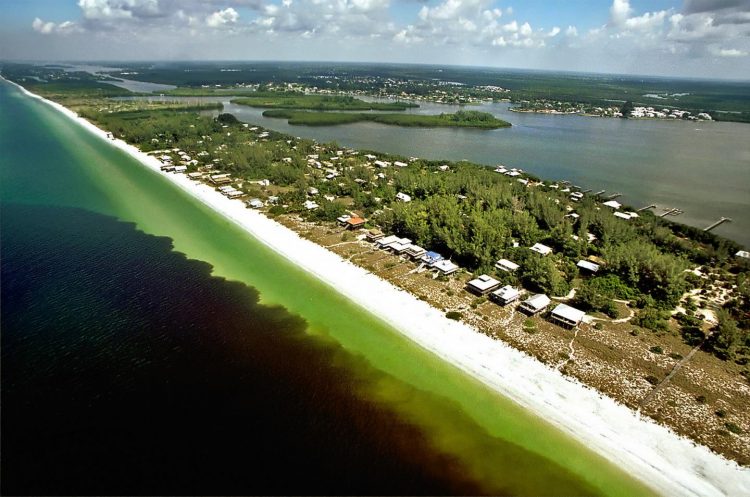Ocean current in Gulf of Mexico linked to red tide

Toxic Karenia brevis blooms (commonly known as Florida red tides) occur often on the West Florida Shelf. These harmful algal blooms are hazardous to marine life as well as to humans (through neurotoxic shellfish poisoning or aerosolized toxins, which cause respiratory distress). Credit: P.Schmidt, Charlotte Sun
A new study found that a major ocean current in the Gulf of Mexico plays an important role in sustaining Florida red tide blooms. The University of Miami (UM) Rosenstiel School of Marine and Atmospheric Science research team suggest that the position of the Loop Current can serve as an indicator of whether the algal bloom will be sustained, and provide warning of possible hazardous red tide conditions in coastal areas.
Florida red tide is a harmful algal bloom produced by the dinoflagellate Karenia brevis that causes respiratory impairment in humans and marine life, and is responsible for shellfish poisoning.
The researchers collected data of Karenia brevis concentrations, river outflows, wind conditions, and sea surface heights to study the physical conditions during periods of large Karenia brevis blooms and periods of no bloom. This research looked at the continuation of a bloom and not the formation of a red tide bloom.
They found that when the Loop Current is in a northern position, it allow a bloom to continue when other conditions were favorable, but when in a southern position a bloom could not be sustained. The Loop Current, which enters the Gulf of Mexico through the Yucatan Straits, is one of the most important features in the Gulf ocean circulation system.
“Knowing the approximate position of the Loop Current can be an indicator if a bloom will be sustained, and provide a warning for possible hazardous conditions,” said UM Rosenstiel School Ph.D. student Grace Maze, lead author of the study.
###
The study, titled “Historical Analysis of Environmental Conditions During Florida Red Tide” was published in the Dec. 2015 issue of the journal Harmful Algae. The study's authors include: Maria J Olascoaga and Larry Brand of the UM Rosenstiel School.
The Oceans and Human Health Center at the University of Miami Rosenstiel School supported the project through a National Science Foundation grant and Gulf of Mexico Research Initiative funds provided by the Consortium provided for Advanced Research on Transport of Hydrocarbon in the Environment (CARTHE).
About the University of Miami's Rosenstiel School
The University of Miami is one of the largest private research institutions in the southeastern United States. The University's mission is to provide quality education, attract and retain outstanding students, support the faculty and their research, and build an endowment for University initiatives. Founded in the 1940's, the Rosenstiel School of Marine & Atmospheric Science has grown into one of the world's premier marine and atmospheric research institutions. Offering dynamic interdisciplinary academics, the Rosenstiel School is dedicated to helping communities to better understand the planet, participating in the establishment of environmental policies, and aiding in the improvement of society and quality of life. For more information, visit: http://www.
Media Contact
All latest news from the category: Life Sciences and Chemistry
Articles and reports from the Life Sciences and chemistry area deal with applied and basic research into modern biology, chemistry and human medicine.
Valuable information can be found on a range of life sciences fields including bacteriology, biochemistry, bionics, bioinformatics, biophysics, biotechnology, genetics, geobotany, human biology, marine biology, microbiology, molecular biology, cellular biology, zoology, bioinorganic chemistry, microchemistry and environmental chemistry.
Newest articles

Pinpointing hydrogen isotopes in titanium hydride nanofilms
Although it is the smallest and lightest atom, hydrogen can have a big impact by infiltrating other materials and affecting their properties, such as superconductivity and metal-insulator-transitions. Now, researchers from…

A new way of entangling light and sound
For a wide variety of emerging quantum technologies, such as secure quantum communications and quantum computing, quantum entanglement is a prerequisite. Scientists at the Max-Planck-Institute for the Science of Light…

Telescope for NASA’s Roman Mission complete, delivered to Goddard
NASA’s Nancy Grace Roman Space Telescope is one giant step closer to unlocking the mysteries of the universe. The mission has now received its final major delivery: the Optical Telescope…



